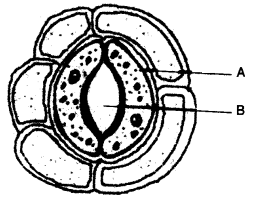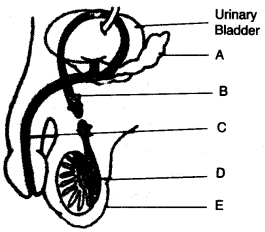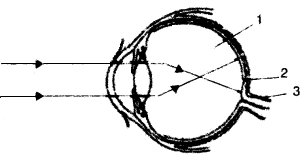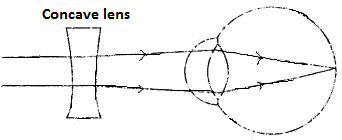ICSE Biology Previous Year Question Paper 2009 Solved for Class 10
ICSE Paper 2009 BIOLOGY
SECTION-I (40 Marks)
(Attempt all questions from this Section)
Question 1:
(a) Name the following :
(i) The statistical study of the human population of a region.
(ii) The biological term given to the protective membranes of the brain.
(iii) The photosensitive pigment present in the rod cells of the retina.
(iv) The cell organelle responsible for photosynthesis.
(v) The internal layer of the eye which prevents reflection of light. [5]
(b) State whether the following statements are true or false. If false, write the correct form of the statement by changing the first or last word only.
(i) The resting stage in mitosis is called interphase.
(ii) Photosynthesis occurs in all the cells of the plant.
(iii) The pituitary gland is both exocrine and endocrine in function.
(iv) Chemicals applied to spots and places to kill harmful microorganism are called disinfectants.
(v) All voluntary actions are controlled by the cerebellum. [5]
(c) Give the specific function of the following structures found in the body of plants I animals :
(i) Hydathodes (ii) Centrosome (iii) Xylem (iv) Corpus luteum (v) Eustachian tube. [5]
(d) Identify and name the following processes f terms from the statements given below
(i) Movement of molecules from a region of high concentration to a region of low concentration.
(ii) Mild chemical applied on the skin to kill germs.
(iii) Chromosomes appear thread like.
(iv) The loss of water from injured parts of a plant.
(v) A pair of chromosomes carrying dissimilar alleles for a particular character. [5]
(e) Classify the following actions as simple reflex or conditioned reflex :
(i) Playing a guitar.
(ii) Removing your hand suddenly when pricked by a thorn.
(iii) Applying sudden brakes when a dog crosses the path.
(iv) Blinking of eyelids on exposure to light.
(v) Tying one’s shoe lace. [5]
(f) The diagram given below is that of a developing human foetus in the womb. Study the same and then answer the questions that follow :
 (i) Name the part labelled 1.
(i) Name the part labelled 1.
(ii) Mention any two functions of the part labelled 2.
(iii) Explain the role played by the part labelled 3.
(iv) What is the norfhal gestation period (in days) of the developing foetus ? [5]
(g) Explain the following terms :
(i) Natality (ii) Photolysis in photosynthesis (iii) Antibiotic (iv) Root pressure (v) Parturition. [5]
(h) Given below are five statements or questions followed by four choices. Select and rewrite the correct answer to the given statements from the four choices given below each statement:
(I) The cerebral hemispheres in mammals are connected by :
(i) Corpus luteum
(ii) Hypothalamus
(iii) Pons varolli
(iv) Corpus callosum
(II) Insulin is secreted by :
(i) Beta cells of pancreas
(ii) Alpha cells of pancreas
(iii) Delta cells of pancreas
(iv) None of the above
(III) A de-starched plant is one whose:
(i) Leaves are free from chlorophyll
(ii) Aerial parts are free from starch
(iii) Leaves are free from starch
(iv) Plant is free from starch.
(IV) The onset of menstruation in the female is termed:
(i) Ovulation
(ii) Menarche
(iii) Menopause
(iv) Parthenogenesis
(V) BCG vaccine provides immunity against:
(i) Tetanus
(ii) Cholera
(iii) Tuberculosis
(iv) AIDS [5]
Answer:
(a) (i) Demography
(ii) Meninges
(iii) Rhodopsin
(iv) Chloroplast
(v) Choroid
(b) (i) True.
(ii) False, “Respiration occurs in all the cells of the plant.
(iii) False, “The pancreas gland is both exocrine and endocrine in function”.
(iv) True.
(v) True.
(c) (i) Hydathodes: Bring about the loss of water but in the form of water droplets.
(ii) Centrosome: Initiates the cell division in animal cells.
(iii) Xylem: Conducts water and inineral salts up to the highest part of the leaves.
(iv) Corpus luteiun : Secretes the hormones such as oestrogen, progesterone and relaxin.
(v) Eustachian Tube: It equalizes atmospheric pressure and pressure in the ear.
(d) (i) Passive transport
(ii) Antiseptic
(iii) Prophase
(iv) Bleeding
(v) Heterozygous
(e) (i) Conditioned Reflex
(ii) Simple Reflex
(iii) Conditioned Reflex
(iv) Simple Reflex
(v) Conditioned Reflex.
(f) (i) Umbilical cord.
(ii) Part labelled 2 is placenta. It two functions are as follows :
(1) Provides diffusion for respiratory gases between mother and foetus.
(2) Removes urea produced by foetus.
(iii) Part labelled 3 is amniotic fluid. Its function is that it acts as a shock absorber and protects the developing embryo from mechanical injuries.
(iv) 280 days.
(g) (i) Natality: The number of children bom per person in the population per unit time is termed as birth rate or natality.
![]() (ii) Photolysis in Photosynthesis: The splitting of water molecules into its two component ions in the’presence of light energy is called photolysis of water.
(ii) Photolysis in Photosynthesis: The splitting of water molecules into its two component ions in the’presence of light energy is called photolysis of water.
![]() (iii) Antibiotics: These are the chemical substances derived from microbes (like bacteria, yeast, moulds) which kill or prevent the growth of other microbes or pathogens. For eg. Penicillin is an antibiotic.
(iii) Antibiotics: These are the chemical substances derived from microbes (like bacteria, yeast, moulds) which kill or prevent the growth of other microbes or pathogens. For eg. Penicillin is an antibiotic.
(iv) Root Pressure: Root pressure is the pressure generated by the cortical cells of the root, which pushes the water and minerals into the xylem of the root for the upward conduction.
(v) Parturition: The delivery of the foetus or the child, birth is technically called as parturition.
(h) (I) (iv) Corpus callosum.
(II) (i) Beta cells of pancreas.
(III) (i) Leaves are free from chlorophyll.
(IV) (ii) Menarche.
(V) (iii) Tuberculosis.
SECTION—II (40 Marks)
(Attempt any four questions from this Section)
Question 2:
(a) The diagram below represents a stage in cell division. Study the same and answer the questions that follow :
 (i) Identify the stage of cell division.
(i) Identify the stage of cell division.
(ii) Name the parts labelled A, B, C and D.
(iii) What is the unique feature observed in this stage ?
(iv) Where does this type of cell division usually occur ?
(v) How many daughter cells are formed from this type of cell division ?
(vi) Is the dividing cell shown a plant or an animal cell ? Give a reason to support your answer. [5]
(b) The diagram below represents a structure found in a leaf. Study the same and answer the questions that follow :
 (i) Name the parts labelled A and B.
(i) Name the parts labelled A and B.
(ii) What is the biological term for the above structure ?
(iii) What is the function of the parts labelled A ?
(iv) Mention two structural features of A, which help in the function mentioned in (iii) above.
(v) Where is this structure likely to be found in a leaf ?
(vi) The above structure helps in the process of transpiration Explain the term transpiration.
(vii) How many other cells are found surrounding this structure as seen in the diagram. [5]
Answer:
(a) (i) Anaphase.
(ii) Part A = Spindle Fiber
Part B = Cell wall
Part C = Chromatid
Part D = Centromere
(iii) Unique feature of this stage : Chromosome are divide into two parts and chromatids are separated which moves towards opposite pole.
(iv) Somatic cells.
(v) Two daughter cells are formed from this kind of cell division.
(vi) Dividing cell shown here is a plant cell because cell wall is clearly visible here which is a unique feature of the plant cells.
(b) (i) Part A = Guard Cells. Part B = Stoma.
(ii) Biological term for the above structure is stomata.
(iii) Part labelled A, i.e., guard cells control the opening and dosing of stomata.
(iv) 1. Guard cells are structurally bean shaped.
2. Wall of guard cells are differently thick. It has inner wall facing towards the stomatal pore is thick and outer wall is thin. By changing the turgidity and flaccidity, guard cells control the opening and closing of stomata.
(v) This structure is more likely to be found on the lower epidermis of the leaves.
(vi) Plants absorb a large amount of water from the soil but only a fraction of.it is used by plants and most of this absorbed water is lost from the aerial parts of the plant in the form of water vapour. It is called transpiration.
(vii) There are five (5) other cells surrounding this structure.
Question 3:
(a) The diagram shows a section of the human brain. Answer the questions that follow :
 (i) Name the parts labelled A, B and C.
(i) Name the parts labelled A, B and C.
(ii) Give the main function of each of the parts A, B, and C.
(iii) Name the three protective membranes covering the brain.
(iv) Name the basic unit of the brain. [5]
(b) (i) Mention any three adaptations found in plarits to favour the process of photosynthesis.
(ii) Why does one feel blinded for a short while on coming out of a dark room ?
(iii) Explain how the rate of transpiration is affected on :
1. a windy day
2. a foggy day. [5]
Answer:
(a) (i) Part A = Cerebrum
Part B = Cerebellum
Part C = Medulla oblongata.
(ii) Cerebrum: It is the site of controlling memory, reasoning, thinking, perception, emotions and speech.
Cerebellum: It maintains posture equilibrium and muscular co-ordination.
Medula Oblongata: It contains centre for cardiac, respiratory and vasomotor activities. It also co-ordinates reflexes for swallowing, coughing, sneezing and vomiting.
(iii) Three protective membranes covering the brain are : duramater, piamater and arachnoid.
(iv) The basic unit of brain is neuron.
(b) (i) Three adaptations found in a green plant in the favour of photosynthesis are:
1. Leaves being thin and flat, offer a large surface area for the process to occur.
2. Internally, the loose arrangement of mesophyll tissue allows rapid diffusion of gases
3. The’high concentration’ of chloroplast in the mesophyll, especially the palisade of the dorsiventral leaves, helps to trap the solar energy
required for the process.
(ii) When we come out from a dark room we feel dazzling effect for a very short period. It is called light adaptation. In this case the diameter of pupil is reduced to allow less light to enter the eyes.
(iii) 1. On a windy day the rate of transpiration increases as moving wind removes the water vapour from around the leaves.
2. On a foggy day, the rate of transpiration decreases, because atmospheric moisture (humidity) is high which inhibits the rate of transpiration.
Question 4:
(a) The diagram given along side represents the structure found in the inner ear. Study the same and then answer the questions that follow :
 (i) Name the parts labelled A, B C and D.
(i) Name the parts labelled A, B C and D.
(ii) Name the part of the ear responsible for transmitting impulses to the brain.
(iii) Name the part labelled above which is responsible for:
1. Static equilibrium.
2. Dynamic equilibrium.
3. Hearing.
(iv) Name the audio receptor cells which pick up vibrations.
(v) Name the fluid present in the inner ear. [5]
(b) Name the hormone responsible for the following functions :
(i) Increase in heart beat.
(ii) Maintains glucose level in the blood..
(iii) Converting Glycogen to Glucose.
(iv) Regulates basal metabolism.
(v) Ossification of bones,
(vi) Prepares the body during emergency.
(vii) Responsible for normal growth of the whole body.
(viii) Regulates the fu nction ing of the male and female reproductive organs.
(ix) Increased reabsorption of water in the kidneys.
(x) Increased blood supply to muscles. [5]
Answer:
(a) (i) Part A = Semicircular canals.
Part B = Utriculus
Part C = Sacculus
Part D = Cochlea
(ii) Auditory Nerve.
(iii) 1. Utriculus and sac culus
2. Semicircular canals.
3. Cochlea.
(iv) Organ of corti.
(v) Endolymph.
(b) (i) Adrenalin
(ii) Insulin
(iii) Glucagon
(iv) Thyroxine
(v) Calcitonin
(vi) Adrenalin
(vii) Somatotropic Hormone (STH)
(viii) Gonadotropic Hormone (GTH)
(ix) Antidiuretic Hormone (ADH)
(x) Adrenalin
Question 5:
(a) The diagram given alongside represents a surgical sterilization method in males. Study the same and then answer the questions that follow:
 (i) Name the parts marked A, B, C, D and E.
(i) Name the parts marked A, B, C, D and E.
(ii) Give the name of the surgical method represented in the diagram.
(iii) Which part is ligated or cut ?
(iv) Name th& corresponding surgical method conducted on females.
(v) Name the part which is ligated in females and why ? [5]
(b) (i) Explain the following terms :
1. Monohybrid cross 2. Gene 3. Phenotype
(ii) Name the two sex-linked diseases in males.
(iii) State Mendel’s law of segregation. [5]
Answer:
(a) (i) Part A = Seminal Vesicle.
Part B = Sperm Duct or Vas Deferens
Part C = Urethra
Part D = Testes
Part E = Scrotum Sac.
(ii) Vasectomy
(iii) Sperm Duct or Vas deferens.
(iv) Tubectomy.
(v) Oviduct. The egg may not meet with the sperms.
(b) (i) 1. Monohybrid Cross: A cross between two parents taking the alternative traits of one single character. For example, a cross between tall and dwarf pea plants.
2. Gene: Genes are the basic unit of heredity and are found on chromosomes. Each character or trait is controlled by one gene.
3. Phenotype: The observable character which is genetically controlled.
(ii) Two sex linked diseases in males are : Haemophilia and Colour blindness.
(iii) Mendel’s Law of Segregation: When Mendel performed cross-pollination between a true-breeding yellow pea plant and a true-breeding green pea plant, he noticed that all of the resulting offspring, F1 generation, were green.
He then allowed all of the green F1 plants to self pollinate. He referred to these off spring as the F2 generation. Mendel noticed a 3 : 1 ratio in pod color. About 3/4th of the F2 plants had green pea pods and about 1/4th had yellowpods.
From these experiments Mendel formulated what is now known as Mendel’s law of segregation. This law states that “allele pairs separate or segreagate during gamete formulation, and randomly unite at fertilization.
Question 6:
(a) The diagram, below represents an experiment conducted to prove the importance of a factor in Photosynthesis. Study the same and then answer the questions that follow :
 (i) Name the factor being studied in this experiment ?
(i) Name the factor being studied in this experiment ?
(ii) Why was the plant kept in a dark room before conducting the experiment ?
(iii) Why was the experimental leaf then kept in (1) boiling water (2) methylated spirit ?
(iv) Name the solution used to test for presence of starch in the leaf.
(v) What will we observe in the experimental leaf at the end of the starch test ?
(vi) Give a balanced chemical equation to represent the process of photosynthesis.
 [5]
[5]
(b) (i) Mention three adaptations found in plants to reduce transpiration.
(ii) Name any three germ killing secretions of our body.
(iii) What are the age restrictions for marriage for boys and girls in India ?
(iv) Mention two activities of the Red Cross. [5]
Answer:
(a) (i) Sunlight
(ii) Plant is kept in a dark room before conducting the experiment, to destarch it.
(iii) 1. In the boiling water, it was kept to kill the cells.
2. In the methylated spirit, it was kept to dissolve the chlorophyll.
(iv) Iodine is used to test for presence of starch in the leaf.
(v) On treating the leaf with iodine solution it shows that the portion of leaf covered with the strip of black paper does not give positive test for starch. The covered portion of leaf indicates the absence of starch after iodine test because it couldnot get light to perform photosynthesis. Hence it is proved that in the absence of light the leaf can not manufacture the starch.
(vi)
(b) (i) 1. The leaves may be covered with thick cuticle.
2. The stomata are sunken in some plants, specially in xerophytes.
3. Some plants contain latex, mucilage, resins etc., tq retain water in the plant body.
(ii) Three germ killing secretions of our body are — tear, saliva and HCl.
(iii) Age restrictipn for marriage for boys is 21 years and for girls it is 18 years.
(iv) Two activities of the Red Cross are :
1. It assists the medical services of a country by providing ambulance services.
2. It provides training for medical and para medical staff for dealing with war and natural calamities.
Question 7:
(a) Given below is a diagram depicting a defect of the human eye. Study the same and then answer the questions that follow :
 (i) Identify the defect.
(i) Identify the defect.
(ii) Name the parts labelled 1, 2, and 3.
(iii) Give two possible reasons for this eye defect.
(iv) Draw a labelled diagram to show how the above mentioned defect is rectified. [5]
(b) Complete the following by filling in the blanks numbered 1 to 10 with the appropriate word/term :
Photosynthesis involves light reaction and dark reaction. During light reaction., the chlorophyll present in the (1) ……… gets activated by absorbing light energy. This energy splits (2) ………. moleccules to (3) ……… and oxygen and releases two electrons. This process is called (4) ……… . The (5) ……… ions are picked up by NADP lo form (6) ……… . The ADP is converted to (7) ……… . This process is called (8) ………. . During the dark phase, the compound, produced at the end of light reaction reacts with carbon dioxide to farm (9) ……… . This product is converted to starch. The process is called (10) ……… . [5]
Answer:
(a) (i) Myopia.
(ii) Part labelled 1 – Vitreous Humor
Part labelled 2 – Yellow spot
Part labelled 3 – Optic Nerve
(iii) Two reasons for this defect are as follows :
1. The eyeball becomes long from front to back.
2. The lens becomes too curved convex.
(iv) This defect is to be rectified by Concave lens

(b) (1) Grana
(2) Water
(3) H+
(4) Photolysis
(5) JET
(6) NADPH
(7) ATP
(8) Photophospherviation
(9) Glucose
(10) Isomerisation.
